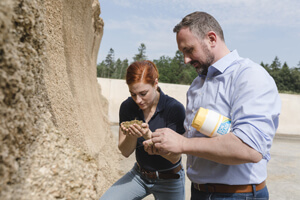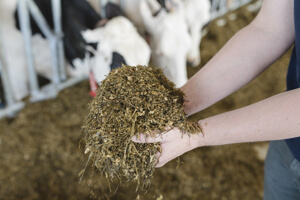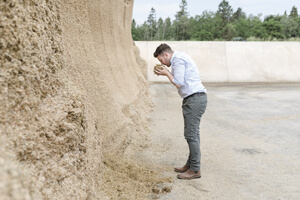The basis for highest performance parameters
Decisions made at chopping time affect forage quality. Determining the optimal timeframe for harvest- ing your haylage or corn silage can be difficult and is influenced by several factors. A harvest that is too wet or too dry can affect yield on one hand and quality on the other. A plan made prior to harvest helps avoid unnecessary issues. Use the following tips to help deliver high quality silage.
When to harvest and how high to cut
Haylage: The optimal harvest time for alfalfa haylage is just be- fore ear emergence, between sprout and blossom. The optimal cutting height is about 3 – 4”, which is high enough to minimize contamination from soil and dirt particles (ash) as well as harm- ful spores. | Delayed harvest can lead to lower protein levels as well as lower NDF digestibility. Choose quality over quantity!
Corn Silage: Harvest corn silage once the dry matter content of the whole plant has reached its ideal stage of approximately 30 – 35%. The dry matter content of the cob should be between 50 – 60% meaning the starch deposition has been completed. Cut- ting height should be about 8” to avoid contamination with soil particles and yeast and fungal spores, which are mainly located in the lower stalk areas. | A corn plant is ready for harvest when the kernel can be slightly indented with a fingernail.
The ideal wilting time is less than 24 hours to avoid unnecessary nutrient losses. In particular, sugar respiration and enzymatic proteolysis that occur during long wilting periods will negatively influence the nutritional value of forages. A longer wilting time also can negatively affect the fermentation process. Finally, leaf losses often occur in low moisture alfalfa forages when they are left to wilt for too long a period.
Chopping length is crucial for various factors that influence the fermentation process as well as final feed quality. Sharp knives are key, and sharpening should be done regularly. Moreover, TLC should be adapted to prevailing dry matter levels. Adequate chopping length also influences packing density, another essen- tial factor for silage quality. | The drier the forage, the shorter the chopping length.
Apply quality silage inoculants that are specifically made for different kinds of forage and various dry matter levels. This will help ensure a successful fermentation process, even when harvest conditions are less-than-ideal.
In general, packing density should be at least 15 lb DM/ft3. As dry matter content increases, packing density also must in- crease to minimize oxygen entrance into the pit. The density can be improved if the pushup does not exceed 6 – 10”.
| Each ton of silage per hour requires 800 lbs of pit tractor weight!
Seal the pit as soon as filling and compaction are completed to stop aerobic degradation processes. A delayed sealing will result in significant losses. An appropriate cover should have an oxy- gen barrier that adheres directly to the silage. The main plastic must be gas-tight and UV-proof.
The feed out should be 6 – 12” per day. Silage pits fed during summer months should be smaller in order to have higher daily feed out. Remove plastic several times a week to have as little surface area exposed to oxygen as possible. In general, the pit size needs to be adapted to herd size and daily feed out.




Target Value
| Technical Parameter | Unit | Corn Silage | Alfalfa Haylage |
|---|---|---|---|
| Cutting height | Inches | 8.0 | 3.0 – 4.0 |
| Theoretical Length of Cut (TLC) | Inches (mm) | 1⁄2 – 3⁄4 (12.5 – 19.0) | 3/8 – 1 (9.5 – 25.4) |
| Packing density | lb DM / ft3 | 15.0 – 18.0 | 15.0 – 18.0 |
| Forage pushup | Inches | 6.0 – 10.0 | 6.0 – 10.0 |
| Nutritional Parameter | |||
|---|---|---|---|
| Moisture | % | 65.0 – 70.0 | 60.0 – 70.0 |
| Dry Matter (DM) | % | 30.0 – 35.0 | 30.0 – 40.0 |
| Crude Protein | % DM | 7.0 – 9.0 | > 19.0 |
| Ammonia | % CP | < 7.0 | < 10.0 |
| ADF | % DM | 20.0 – 30.0 | < 35.0 |
| aNDF | NDFom % DM | 35.0 – 45.0 | 35.0 – 40.0 |
| NDF30 | % NDF | > 55.0 | > 52.0 |
| Starch | % DM | > 30.0 | – |
| Starch digestibility (7hr) | % Starch | > 85.0 | – |
| Ash | % DM | < 5.0 | < 10.0 |
| Net Energy Lactation | Mcal/lb | > 0.7 | > 0.64 |
| pH Value | 3.7 – 4.2 | 4.0 – 4.8 |

 Deutschland
Deutschland International
International Brasil
Brasil Español
Español